|
Brooches, Bracelets,
Rings, and More
by Bob Brooke
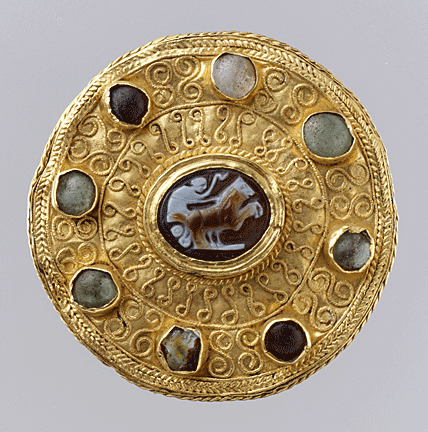 The
ancient Romans, both men and women, loved to adorn themselves with gold,
colored gemstones and glass. The ancient Greeks, on the other hand,
preferred fine quality metalwork in gold or silver. The
ancient Romans, both men and women, loved to adorn themselves with gold,
colored gemstones and glass. The ancient Greeks, on the other hand,
preferred fine quality metalwork in gold or silver.
Most Romans were highly conscious of how they presented themselves in
public. Both men and women frequently used body ornamentation to
demonstrate their wealth, power, influence, and knowledge. Bureaucrats
and senators wore gold rings featuring large flashy gemstones to signal
status. Roman aesthetic values led to the increased use of precious and
semi-precious gemstones as well as colored glass in jewelry.
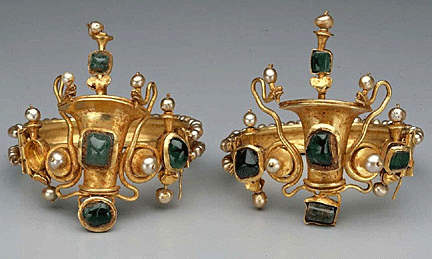 Examples
of jewelry worn by the higher social classes include solid gold
necklaces, earrings, bracelets, rings, and fibulla (brooches) with many
variations within these classes of jewelry. Some bracelets, such as
golden ones shaped like snakes, had no clasps while others used gold
pins or small gold screws to fasten the bracelet to the wrist. Examples
of jewelry worn by the higher social classes include solid gold
necklaces, earrings, bracelets, rings, and fibulla (brooches) with many
variations within these classes of jewelry. Some bracelets, such as
golden ones shaped like snakes, had no clasps while others used gold
pins or small gold screws to fasten the bracelet to the wrist.
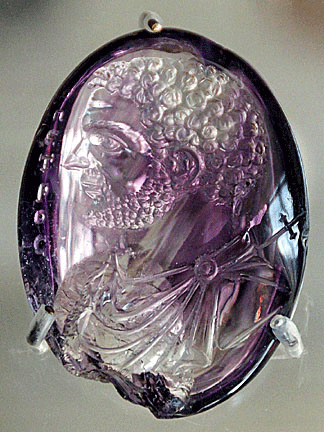 Different
genders and social classes in Rome used various types of jewelry for
aesthetic purposes and to communicate social messages of status and
wealth. Throughout the history of the Roman Empire, Greek, Egyptian, and
Etruscan jewelry styles influenced Roman ones. Different
genders and social classes in Rome used various types of jewelry for
aesthetic purposes and to communicate social messages of status and
wealth. Throughout the history of the Roman Empire, Greek, Egyptian, and
Etruscan jewelry styles influenced Roman ones.
Most Romans preferred an ostentatious and creative use of color over
fine metalwork. Glass makers were supposedly so skilled that they could
fool the public into thinking that glass beads and ornaments were
actually gemstones. When jewelers did use genuine gems, the stones
preferred by Roman women were amethyst, emerald, and pearl, though
pearls were rare and expensive and used only until the end of the
Republic. They did use clusters of large pearl beads to make earrings
called crotalia, or rattles.
Jewelry Materials and Style
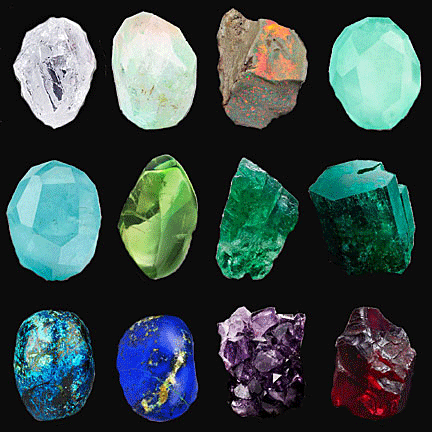 Roman
jewelry workshops got their precious and semi-precious gemstones from
traders that had traveled down the Persian Silk Road from the East and
Far East. Jewelers imported semiprecious stones like garnet, emeralds,
peridots, jasper and lapis lazuli from Egypt. They brought in onyx,
amber and moonstone in from the Persian Gulf which they embedded in
earrings, rings, and brooches. Roman
jewelry workshops got their precious and semi-precious gemstones from
traders that had traveled down the Persian Silk Road from the East and
Far East. Jewelers imported semiprecious stones like garnet, emeralds,
peridots, jasper and lapis lazuli from Egypt. They brought in onyx,
amber and moonstone in from the Persian Gulf which they embedded in
earrings, rings, and brooches.
Other than gold, Romans also used bronze, Roman glass, bone beads and
precious gemstones which were excavated from far off places like Persia,
Far East, and the Indus Valley.
 Diamonds,
emeralds and sapphires found their way from the silk route to the Roman
land to appease the rich and mighty of this civilization. Diamonds,
emeralds and sapphires found their way from the silk route to the Roman
land to appease the rich and mighty of this civilization.
While patricians placed much emphasis on fine gold and silver pieces of
antiquated jewelry, many pieces worn by lower social classes in Rome
would have been made out of bronze or other less expensive metals.
Unlike ancient Greek jewelers, Roman manufacturers would have dealt
primarily with mass-produced pieces created using molds and casting
techniques. This allowed more people to afford such accessories.
Roman Jewelry for Women
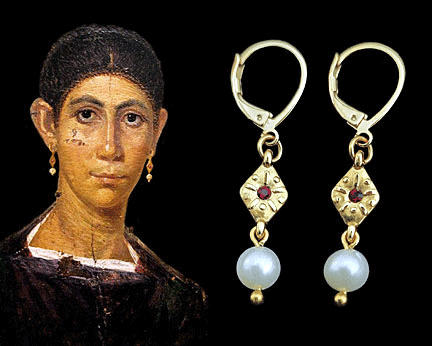 Roman
women collected and wore more jewelry than men. The elite women of Roman
society were expected to wear an abundant amount extravagant and
expensive gold jewelry to show their familial status. Roman
women collected and wore more jewelry than men. The elite women of Roman
society were expected to wear an abundant amount extravagant and
expensive gold jewelry to show their familial status.
They lavished themselves with different jewelry sets and adorned their
bodies with rings, bracelets, earrings, and necklaces all worn at the
same time. Jewelry artisans even bedecked functional accessories such as
brooches or pins to fasten garments with gemstones, and often created
them from precious metals. Earrings, specifically boat-shaped earrings
wrought from precious metals were one of the most popular items in Rome
among women. They usually had pierced ears, in which they would wear one
set of earrings.

Jewelry was particularly important to women because Roman society
considered it to be their own property, which could be kept
independently of their husband's wealth and used as the women saw fit.
They had the right to buy, sell, bequeath, or barter their own jewelry.
The way an elite woman dressed, accessorized, and presented herself in
public reflected the rank of her husband.

 Solid
gold snake bracelets, symbolizing mortality, were the most popular types
of Roman jewelry for women who often wore them in pairs, around their
wrists as well as on their upper arms. Solid
gold snake bracelets, symbolizing mortality, were the most popular types
of Roman jewelry for women who often wore them in pairs, around their
wrists as well as on their upper arms.
The women of the Roman Empire wore earrings primarily to embellish their
faces, it was also to symbolize their value or position in society.
Amethyst, which served as a sign of enchantment, were one of the most
popular materials that could be embedded in earrings.
Roman Jewelry for Men
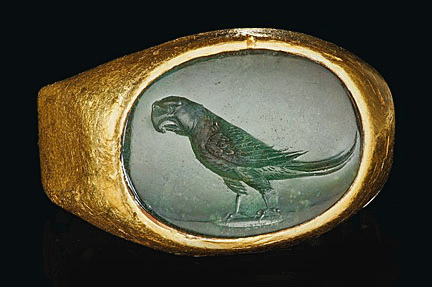 Roman
men wore less jewelry than their female counterparts. An Imperial
noblemen's ornamentation represented personal achievement and status. Roman
men wore less jewelry than their female counterparts. An Imperial
noblemen's ornamentation represented personal achievement and status.
Finger rings and fibulae were the most common forms of jewelry worn by
men, but they would also sometimes wear pendants. Roman men, unlike
Greek men, wore multiple rings at once. Senators and bureaucrats wore
gold rings with a large gemstone that, at a glance, indicated their
high-ranking status.
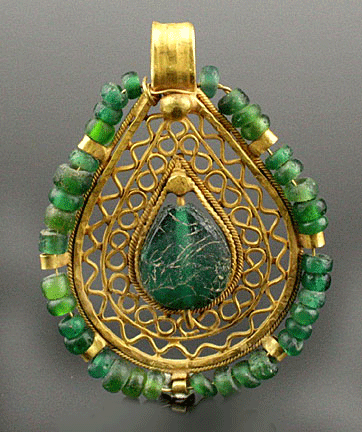 Plebeians, or commoners, could only wear rings of iron, although
occasionally they received rings of gold as a sign of bravery in battle. Plebeians, or commoners, could only wear rings of iron, although
occasionally they received rings of gold as a sign of bravery in battle.
Necklaces
Both
men and women, rich and poor alike, wore necklaces. Most Romans leaned
towards wearing a pendant rather than simple, choker-like necklaces.
Pendants had the image of the Emperor stamped upon them, or were adorned
with a gemstone embedded in gold or silver.

Brooches
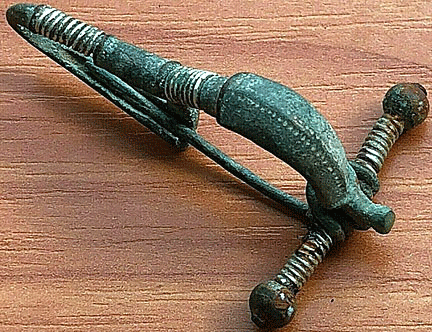 Another
common and most practical jewelry in that period was the fiblula, or
brooch. Its purpose was to attach pieces of clothing and bring
sophistication to the attire. Instead of sewing clothing items, Romans
liked to fastened them with fibula and clasps made of gold, silver, or
bronze. Jewelers decorated fibulas with a carved stone, especially cameo
portraits and other popular designs. Another
common and most practical jewelry in that period was the fiblula, or
brooch. Its purpose was to attach pieces of clothing and bring
sophistication to the attire. Instead of sewing clothing items, Romans
liked to fastened them with fibula and clasps made of gold, silver, or
bronze. Jewelers decorated fibulas with a carved stone, especially cameo
portraits and other popular designs.
Intaglios
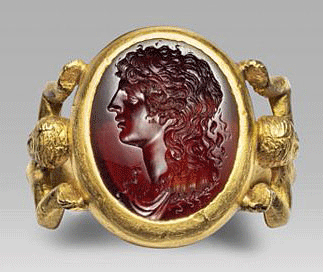 One
of the most common forms of jewelry decoration was the intaglio. Romans
often used them as personal seals or amulets. Jewelers typically mounted
them on rings which the wearers could press into wax or clay to create a
personal signature. The artistry involved in crafting these tiny works
of art required great skill, as the stones needed to be meticulously
engraved with minute details. The Roman period saw significant
development in gem carving techniques, often facilitated by specialized
artisans working with intricate tools. One
of the most common forms of jewelry decoration was the intaglio. Romans
often used them as personal seals or amulets. Jewelers typically mounted
them on rings which the wearers could press into wax or clay to create a
personal signature. The artistry involved in crafting these tiny works
of art required great skill, as the stones needed to be meticulously
engraved with minute details. The Roman period saw significant
development in gem carving techniques, often facilitated by specialized
artisans working with intricate tools.
< Back
to Collectibles Archives
Next
Article >
|
